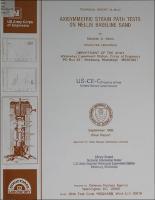Please use this identifier to cite or link to this item:
https://hdl.handle.net/11681/11247| Title: | Axisymmetric strain path tests on Nellis baseline sand |
| Authors: | United States. Defense Nuclear Agency Akers, Stephen A. |
| Keywords: | Laboratory tests Strain path tests Remolded specimens Stress path tests Sand with clay Sandy soils Soil mechanics Nellis baseline sand |
| Publisher: | Structures Laboratory (U.S.) Engineer Research and Development Center (U.S.) |
| Series/Report no.: | Technical report (U.S. Army Engineer Waterways Experiment Station) ; SL-86-24. |
| Description: | Technical Report Abstract: This report documents the results of a laboratory testing program conducted by the US Army Engineer Waterways Experiment Station (WES) in which the responses of cylindrical specimens of Nellis baseline (NB) sand were measured under imposed axisymmetric strain path loadings. Two strain path shapes (designated as shapes 2 and 3) were investigated, each having three levels of strain magnitude (A, B, and C) for a total of six strain paths. It was found that a unique stress path was produced by following a given strain path. This was true for all of the six strain paths investigated. All of the strain path tests which followed shape 3 reached a point of continuing strain with little change in the applied stresses. These specimens appeared to be yielding or flowing as the stress path moved along a failure envelope. Reverse strain path tests (tests which followed a stress path generated by a previous strain path test) proved that a unique strain path was not necessarily produced by following a given stress path. When stress paths developed by strain path shape 3 were followed, several different strain paths were produced. The resulting strain magnitudes were directly dependent upon the length of time the stress path spent moving along the failure envelope. Results of a series of strain-rate tests indicated that the NB sand exhibited an 18 percent increase in peak stress difference when loading times were decreased from 133 to 4 minutes. These times represent the practical bounds for the WES manually controlled test system. To achieve faster strain rates, an automated system is needed. |
| Rights: | Approved for public release; distribution is unlimited. |
| URI: | http://hdl.handle.net/11681/11247 |
| Appears in Collections: | Technical Report |
Files in This Item:
| File | Description | Size | Format | |
|---|---|---|---|---|
| TR-SL-86-24.pdf | 18.61 MB | Adobe PDF |  View/Open |